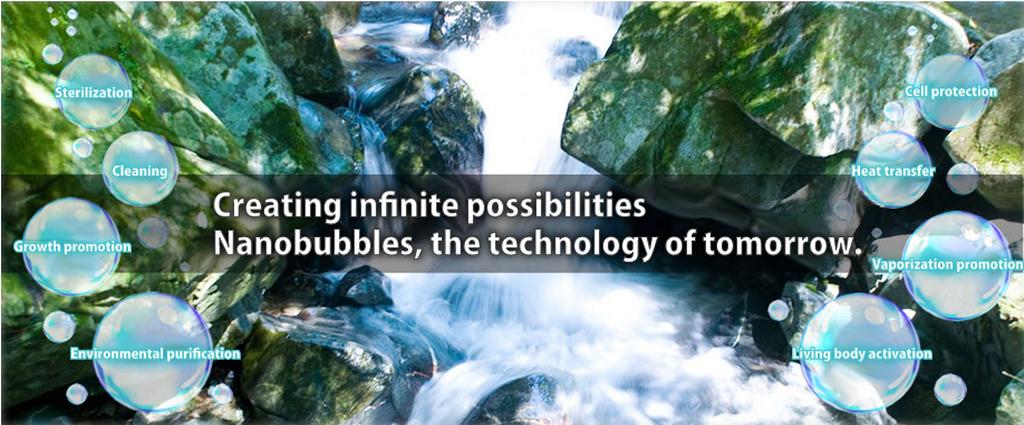Nanobubble Solutions Limited offers a new and unique Japanese carbon ceramic technology that places any gas into any liquid, in almost any environment. Working by osmosis and surpassing everything that has gone before, Anzai's Patented Nanobubble technology can guarantee 90% gas transfer rate (gas remaining in the liquid) IN ONE PASS and offers unrivalled scalability, using a fraction of the energy required by other methods. The effectiveness and scalability of our Nanobubble technology offers flexible and cost-efficient solutions to a far greater number of commercial and industrial applications than ever before.

benefits of our new technology
 | works by osmosis with no mechanical parts |
 | can place any gas into any liquid |
 | gas remains in liquid and in ONE PASS guarantees a 90% gas transfer/saturation rate (double any other system) |
 | works on very low pressure, maximum 29psi |
 | operational in high temperatures |
 | extremely low energy requirement so outstanding cost effectiveness |
 | can place nanobubbles into liquids of high viscosity (think mayonnaise) |
 | can easily up-size to large scale production without increase in pressure or energy |
 | in-line, rotary/propeller and ultrasonic methods of delivery - making nanobubbles available to a far greater number of industries (for example pharmaceutical and mining/ferric leaching) |
 | replaces or reduces need to use chemicals, so more environmentally friendly |
 | electrical charge and high frequency induction heating allowed |
properties of nanobubbles
Nano or ultrafine bubbles have a diameter of less than 50 microns and unique physical characteristics that differ from other types of bubbles. They are too small to rise up through liquid and get compressed by negative ions at the gas-liquid interface so don’t combine to form larger bubbles. This means they remain in the liquid for a long time. They then shrink leaving their entire gas load in the liquid.
| sterilization capability | The agglomeration and collapse process of the nanobubbles converts oxygen in the air into active oxygen, creating bactericidal molecules including OH and O3. |
| cleaning capability | Ions existing at the gas-liquid interface of the nanobubbles decompose and adsorb oil and fat contamination, which allows removal of the contamination without the need for cleaning agents. |
| bio-activation capability | It has been proven that the nanobubbles penetrate deep into biological cells and enhance the immunity of the cells. This has allowed elimination of the need for antibiotics or reduction of the amount of antibiotic usage. |
| growth promotion capability | It has been verified that using the nanobubbles allows fish, crustacea and plants to be grown 20 to 30 percent larger than those grown in an ordinary manner. |
| cell protection capability | It has been found that oysters grown with nanobubbles remain alive even if they are frozen to minus 20°C. This is likely because the nanobubbles protect oysters' cells against damage due to freezing. |
| heat transfer capability | Nanobubbles can be used to raise or lower the temperature of a liquid rapidly and effectively. |
| vaporization promotion capability | It has been proven that the nanobubbles contained in a liquid promote vaporization of the liquid. Applications based on this effect include highly efficient water-cooled cooling towers and evaporation based desalination systems. |
| environmental purification capability | The nanobubbles help restore the biological balance in lakes, rivers or seas and remove odours and toxic substances produced by anaerobic bacteria. This effect stays for a long time even in a large water body such as oceans and seas. |

find out more
You can read more about the technical aspects of our technology on our technical page and find out more about how it is being used on our applications page. There's more about our business here. If you are a business interested in exploring our technology then please contact us.
Copyright © 2024 Nanobubble Solutions Limited
web site by Shepperton Software

web site by Shepperton Software

